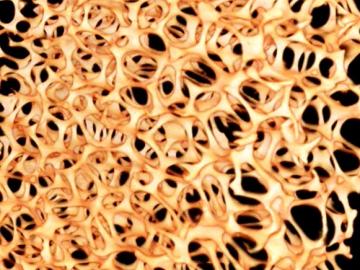Filter News
Area of Research
- (-) Neutron Science (15)
- Advanced Manufacturing (11)
- Biology and Environment (18)
- Building Technologies (4)
- Clean Energy (65)
- Climate and Environmental Systems (1)
- Computational Biology (1)
- Computational Engineering (2)
- Computer Science (9)
- Electricity and Smart Grid (1)
- Fusion and Fission (3)
- Fusion Energy (4)
- Isotopes (4)
- Materials (24)
- Materials for Computing (9)
- Mathematics (1)
- National Security (3)
- Nuclear Science and Technology (7)
- Quantum information Science (3)
- Renewable Energy (1)
- Sensors and Controls (1)
- Supercomputing (11)
- Transportation Systems (2)
Media Contacts

Neutron scattering techniques were used as part of a study of a novel nanoreactor material that grows crystalline hydrogen clathrates, or HCs, capable of storing hydrogen.

Oak Ridge National Laboratory researchers are developing a first-of-its-kind artificial intelligence device for neutron scattering called Hyperspectral Computed Tomography, or HyperCT.

Textile engineering researchers from North Carolina State University used neutrons at Oak Ridge National Laboratory to identify a special wicking mechanism in a type of cotton yarn that allows the fibers to control the flow of liquid across certain strands.


Researchers from NASA’s Jet Propulsion Laboratory and Oak Ridge National Laboratory successfully created amorphous ice, similar to ice in interstellar space and on icy worlds in our solar system. They documented that its disordered atomic behavior is unlike any ice on Earth.

Researchers at Oak Ridge National Laboratory’s Spallation Neutron Source have developed a diamond anvil pressure cell that will enable high-pressure science currently not possible at any other neutron source in the world.

Researchers at Oak Ridge National Laboratory demonstrated that metal foam enhances the evaporation process in thermal conversion systems and enables the development of compact HVAC&R units.

Researchers used neutron scattering at Oak Ridge National Laboratory’s Spallation Neutron Source and High Flux Isotope Reactor to better understand how certain cells in human tissue bond together.

Researchers used neutron scattering at Oak Ridge National Laboratory’s Spallation Neutron Source to probe the structure of a colorful new material that may pave the way for improved sensors and vivid displays.

Researchers have pioneered a new technique using pressure to manipulate magnetism in thin film materials used to enhance performance in electronic devices.




